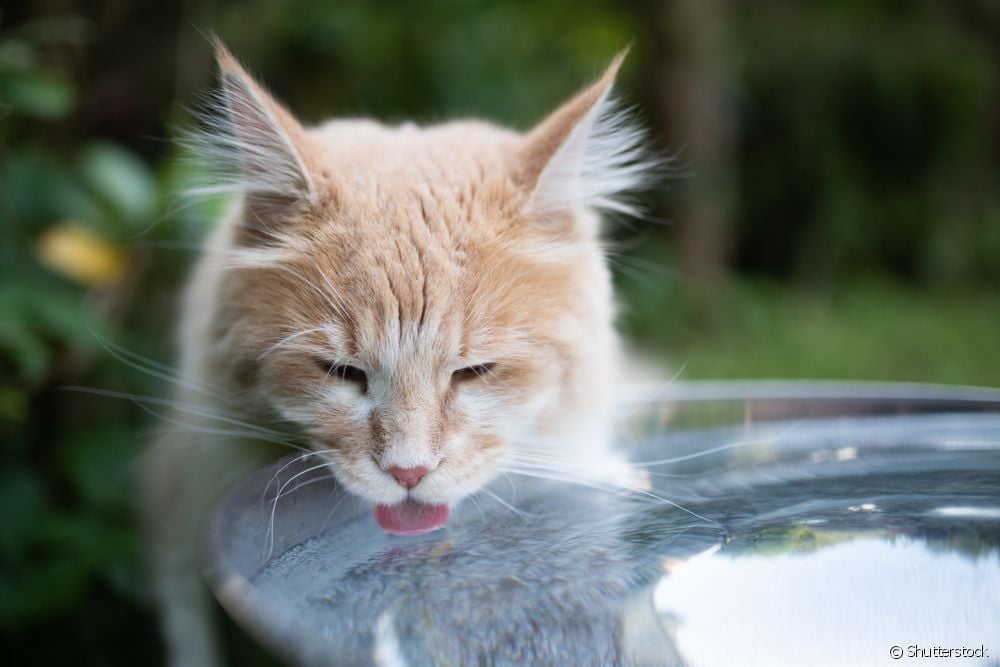Is drinking too much water normal for a cat, and could it indicate a health problem?

Table of contents
Have you noticed your cat drinking too much water? This is normal and a hydrated feline is even healthy in some cases - a sign that the weather is warmer, for example - but it may also indicate that some more serious illness is affecting your pet. So it's good to keep an eye out and notice if he's often going to the water bowl, looking for water in the box or hunting for one.tap running through the house.
Excessive water consumption, known as polydipsia in the medical vocabulary, starts to become worrying when the amount ingested by the feline exceeds 45 ml/kg per day. From pathological and compensatory reasons to behavioral factors, learn below what problems may be related to your kitten's endless thirst.
Cats with diabetes: types mellitus and insipidus cause cats to drink a lot of water
Cat diabetes can be quite serious. Diabetes mellitus is a disorder in which the blood sugar level rises due to insulin deficiency, or an insensitivity of the body's cells to available insulin. During the process, the glucose build-up in the bloodstream is eliminated through urine. This causes the cat to use its litter box a lot and to drink plenty of water to replenish what it needs.has been lost from the body.
Diabetes insipidus, also called "water diabetes", is a rarer form of the disease. Since the main cause is related to inadequate secretion of the antidiuretic hormone ADH, the cat affected by this type of diabetes also drinks a lot of water, as well as urinating a very clear liquid frequently.
Kidney failure in cats can also cause excessive thirst
Feline renal failure, or chronic kidney disease (CKD), affects mainly elderly cats - and all too often, unfortunately. When the animal's kidneys begin to fail, the cat produces progressively more dilute urine (polyuria). And to regain its hydration levels, the cat with renal failure needs to replace the water lost by the body.
Hyperadrenocorticism in cats: thirst is one of the main symptoms of the disease
Hyperadrenocorticism, also known as Cushing's disease, develops when there is an excessive and persistent production of the hormone cortisol by the adrenal glands. The condition can cause a number of complications in your kitty, including excessive thirst, frequent urination, weakness, loss of appetite and skin changes. It is also common for the animal with "hyperadreno" to have an abdomenpendular and distended.
Hyperthyroidism can increase kitten's water consumption
Hyperthyroidism is a common disease in cats and mainly affects middle-aged and older animals. The problem is caused by an increase in the production of thyroid hormones (known as T3 and T4) from an enlarged thyroid gland in the cat's neck. Among the most common clinical signs are weight loss, increased appetite, hyperactivity, vomiting, diarrhea, increasedthirst and frequent urination.
Diarrhea and vomiting make the kitten lose a lot of fluid and drink water
Diarrhoea and vomiting are two conditions that cause the body to lose a lot of fluid. Sick cats then increase their water intake to compensate. If the problem lasts longer than 24 hours, you should seek veterinary care to investigate whether there is an underlying disease.

Other reasons behind the cat drinking excess water
A cat drinking too much water is not always related to a health problem. Before suspecting something more serious, it is important to know that each cat has its own lifestyle and particularities. A feline living on the street, for example, will be much thirstier than a lazy kitten, who spends all day lying on the sofa. See other everyday situations that can make your catdrink plenty of water:
See_also: Dog heartbeat: what rate is considered normal and how to measure it?- Cats that are fed very dry food may drink a lot of water to make up for what their meals don't provide. Therefore, a pet that eats wet food doesn't need to make as many trips to the water fountain. Foods with more salt can also increase a pet's thirst;
- Cats in hot weather are often panting more, and this natural cooling feature causes them to lose a lot of water, which obviously needs to be replaced at some point;
- Overheating is a temporary condition - just like us humans, cats may need an increased volume of water after a routine of exercise and play.

